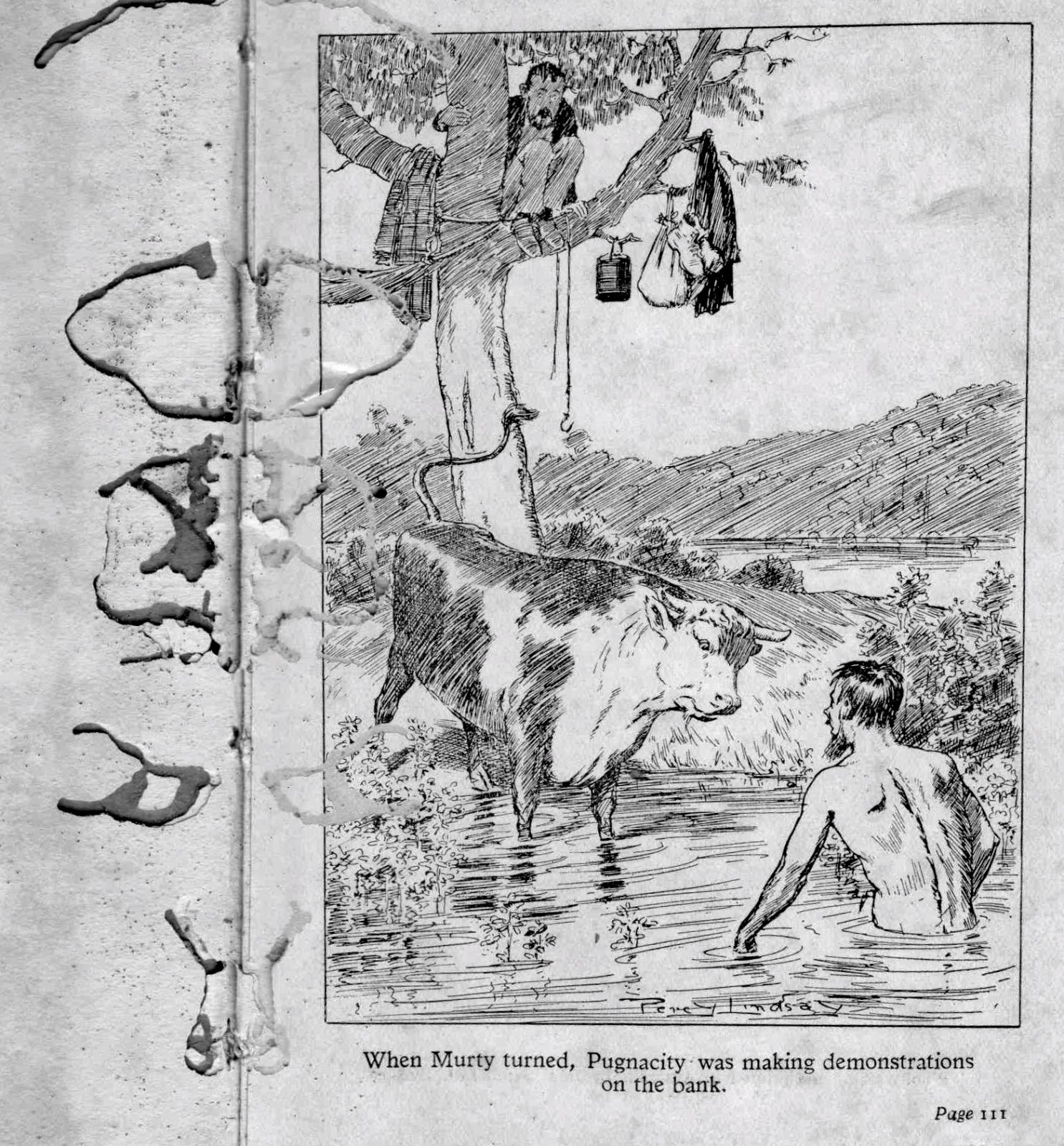Wormed ,faded, bumped, foxed , gored by a bull? ,
this unusual 1925 novel Murty
Brown , written by
Edward Sylvester Sorenson , illustrated
by Percy Lindsay , was unearthed
at a North Queensland book fair and is an example of the
kind of offbeat items this blog
likes...rudely described by an antique dealer
as “ poop.”
Despite that unkind assessment , researching purchases
such as this
keeps you off
the streets . Often it reveals
quaint , informative and reprehensible attitudes in early Australia...in this case giving opium to Aborigines
as payment for a scheme to get rich killing and skinning wallabies
in Queensland .
Author Sorenson ( 1869-1939 ), was born
in the small town of Dryaaba,
near Casino , in the northern rivers region of
NSW. He left school
aged 14, prospected for gold in
Queensland and worked on sheep stations ; after numerous jobs in South Australia , Victoria and NSW, he settled in Sydney and took up a course
to become a writer, drawing on his wide
experiences in the bush , resulting
in several books , ballads , poems and other works , likened to
Henry Lawson and Steele Rudd . His urge to write was encouraged by one of the founders of The Bulletin , J. F. Archibald , and he became one of the most prolific writers about the Australian bush .
Sorenson's wife , Alice , a widow
when he married her , was the daughter of a bush worker on big pastoral runs and was said to be
welcoming to any visitor from North Queensland .
Seemingly showing elements of Mark Twain’s adventures of Tom Sawyer and
Huckleberry Finn, the rollicking novel
opens with an account of a man who transports cedar logs on a raft down the Richmond River ; Murty Brown and knock about mates enter the scene , he , it is revealed , has a map for a mysterious
island in a lake on which some documents of importance
are buried , location unsure ,that could make Murty rich.
In the travels, a ragtag
army of men is encountered , armed with an array
of weapons-breech loaders, muzzle loaders , pistols, revolvers , pea rifles
, muskets , blunderbusses and tomahawks , spears and boomerangs - led by an Aborigine
, Saucepan , in top hat and frock coat , under the command of Dick Daghorn.
Called the Flying Fox
Extermination Society, the "regiment" included a barefooted
bugle boy armed with a catapult, his musical instrument made from a polished cow horn.
The intention is to
slaughter as many unsuspecting flying
foxes as possible in a colony of
some 40,000 .The actual killing of the bats is described in gleefull detail, there being talk of wounded and
flapping foxes being clubbed with waddy and gun . In the “battle”, some of the army were
injured.
In a later
chapter headed: "THE QUEENSLAND
MARSUPIAL COMPANY”, it tells how Murty and others get involved in the
get rich scheme involving paying
Aborigines with opium bought from a
Chinaman to hunt and skin wallabies. The
person who puts forward the scheme to Murty
turns out to be a conman and stated that “blacks” will do anything for opium.
Wandering about
the outback , Murty eventually receives
information which seems to indicate the
place he is searching for is Koponey’s
Island, where a valuable cargo was reputedly hidden by Koponey (a play on American gangster Al Capone ?) when he was dodging police.
On the
island the search for the cache
proceeds but Murty and a mate are chased by a scrub bull they nicknamed Pugnacity, see mutilated illustration below, eventually killed with a hatchet. Needless to say, no
hidden trove is found .
However there is a subsequent twist involving a Chinaman with much gold , becoming sick, floating down the river on a raft of logs, his gold and bones buried on...Koponey's Island . Murty, 47 , and others retrieve the gold and the bones of the Chinaman, troopers step in and there is a court case in Toowoomba , Queensland , which collapses. Murty, as sentimental as an axe handle , somehow ends up with a reward and the wherewithal to have his own homestead.
In several places throughout the book appears the
name D.J.Cracknell of “Monzone”, 97 Willison Road, Carlton, Sydney, a builder , awarded NSW government contracts in the
l930s for a new pathology building at the Coast Hospital and alterations and renovations to Primrose House, the St. George District Hospital convalescent home . His wife , nee Minnie Munds, gave birth to a daughter at their residence on March 4,1914. It may be an extreme flight of fantasy to suggest that mention of the Muddle family ,with two daughters , on the Richmond River , in the book in some way could be linked with Minnie Munds . Murty Brown was Sorenson's last novel and is available online on the Project Gutenberg Australia home page .




